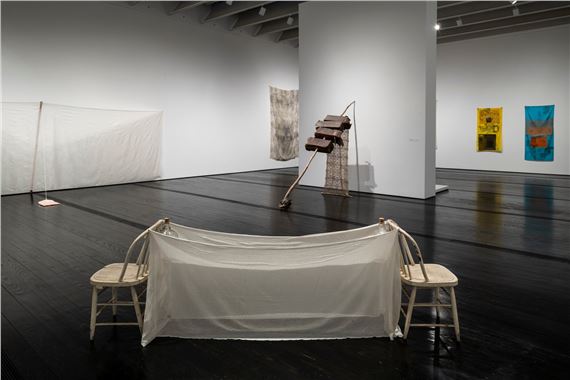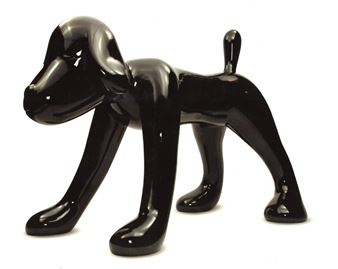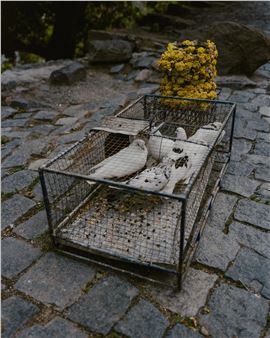Robert Rauschenberg: Fabric Works of the 1970s
The Menil Collection opens Robert Rauschenberg: Fabric Works of the 1970s on September 19. The presentation features major loans from museum collections and the artistÔÇÖs foundation and will be the first museum survey of RauschenbergÔÇÖs innovative use of cloth in this era. Organized for the artistÔÇÖs centennial in collaboration with the Robert Rauschenberg Foundation, Robert Rauschenberg: Fabric Works of the 1970s will be on view at the Menil through March 1, 2026.
Born in Port Arthur, Texas, a small coastal town ninety miles east of Houston, Robert Rauschenberg (1925ÔÇô2008) is an influential figure in the history of modern and contemporary art. Renowned for his ability to break down categories between art and life, he expanded the very definition of art. After a brief time at University of Texas at Austin and serving in the Navy, he came of age in the New York art world of the late 1950s. By 1964, he was lauded in the press as the most important American artist since Jackson Pollock.
In the 1970s, the artist turned to the expressive potential of textiles, from diaphanous silk and delicate lace to roughly hewn cheesecloth and stained drop cloths, in multiple series that celebrate the formal properties of fabric and present an unexpected array of artistic gestures. The artist draped, folded, suspended, and propped the soft medium into dynamic and layered physical arrangements.
In this decade, Rauschenberg had also begun spending more time away from New York at his home on Captiva Island off the Gulf Coast of Florida. Here, he began exploring more extensively how woven materials hold printed images, move in the air, respond to gravity, and capture color and light. Building on the innovations of minimalism, Rauschenberg adopted flexible, open, and sail-like structures distinguished by vivid hues within a reduced vocabulary of form.
Rebecca Rabinow, Director, The Menil Collection, said, ÔÇ£Robert Rauschenberg was a close friend of the Menil. He first met the museumÔÇÖs founders John and Dominique de Menil in the early 1960s. He attended the inauguration of the museum in 1987 and subsequently was the subject of several major exhibitions organized by the MenilÔÇÖs curators. We are proud to continue this lineage and work with the Robert Rauschenberg Foundation to mark the centennial of the artist's birth, directing attention to an intriguing yet understudied facet of RauschenbergÔÇÖs oeuvre.ÔÇØ

Recommended for you
The Menil Collection opens Robert Rauschenberg: Fabric Works of the 1970s on September 19. The presentation features major loans from museum collections and the artistÔÇÖs foundation and will be the first museum survey of RauschenbergÔÇÖs innovative use of cloth in this era. Organized for the artistÔÇÖs centennial in collaboration with the Robert Rauschenberg Foundation, Robert Rauschenberg: Fabric Works of the 1970s will be on view at the Menil through March 1, 2026.
Born in Port Arthur, Texas, a small coastal town ninety miles east of Houston, Robert Rauschenberg (1925ÔÇô2008) is an influential figure in the history of modern and contemporary art. Renowned for his ability to break down categories between art and life, he expanded the very definition of art. After a brief time at University of Texas at Austin and serving in the Navy, he came of age in the New York art world of the late 1950s. By 1964, he was lauded in the press as the most important American artist since Jackson Pollock.
In the 1970s, the artist turned to the expressive potential of textiles, from diaphanous silk and delicate lace to roughly hewn cheesecloth and stained drop cloths, in multiple series that celebrate the formal properties of fabric and present an unexpected array of artistic gestures. The artist draped, folded, suspended, and propped the soft medium into dynamic and layered physical arrangements.
In this decade, Rauschenberg had also begun spending more time away from New York at his home on Captiva Island off the Gulf Coast of Florida. Here, he began exploring more extensively how woven materials hold printed images, move in the air, respond to gravity, and capture color and light. Building on the innovations of minimalism, Rauschenberg adopted flexible, open, and sail-like structures distinguished by vivid hues within a reduced vocabulary of form.
Rebecca Rabinow, Director, The Menil Collection, said, ÔÇ£Robert Rauschenberg was a close friend of the Menil. He first met the museumÔÇÖs founders John and Dominique de Menil in the early 1960s. He attended the inauguration of the museum in 1987 and subsequently was the subject of several major exhibitions organized by the MenilÔÇÖs curators. We are proud to continue this lineage and work with the Robert Rauschenberg Foundation to mark the centennial of the artist's birth, directing attention to an intriguing yet understudied facet of RauschenbergÔÇÖs oeuvre.ÔÇØ
Artists on show
Contact details

Related articles
Seven institutional shows are planned for the artist's centennial next year, accompanied by the first volume of a catalogue raisonn├®...
2025 Fall Preview: Six Texas Art Exhibitions to See this Year.
Art lovers attending New York Fashion Week might notice reference to a familiar figure in Jason WuÔÇÿs Spring 2026 collection.
A partnership between the painter's foundation and designer Jason Wu will mark the beginning of a yearÔÇælong celebration marking the artist's centenary.

 ARTISTS
ARTISTS















